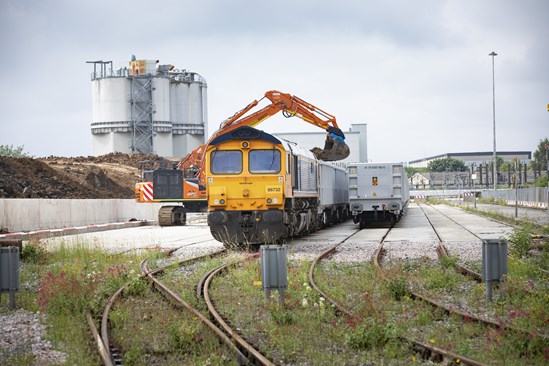Many of our sites are close to the existing rail network so freight trains are a great way to deliver heavy construction materials such as aggregate (crushed stone used in construction) and tunnel segments and help remove excavated materials.
Taking trucks off local roads in Buckinghamshire
In the central part of the route, the main delivery hub is currently the Quainton Railhead run by our main works contractor EKFB, a team made up of Eiffage, Kier, Ferrovial Construction and BAM Nuttall.
Trains come from quarries across the UK, with the latest deliveries coming from the Penmaenmawr quarry in North Wales, travelling 269 miles to site via the iconic Conwy Castle (see photo - CREDIT: DC Rail). In total, up to 56 train loads of material are expected to be delivered from Penmaenmawr between now and summer 2026.
From here, aggregate is moved north and south to where it’s needed along EKFB’s 80km section of route via a series of internal haul roads – helping to take lorries off local roads.
Before the current Quainton railhead was opened in November 2022, EKFB used smaller temporary railheads nearby as well as on the Princes Risborough to Aylesbury line and at Calvert. As of June 2025, and incredible 1862 train loads of material have been delivered across all their railhead locations in an operation managed by Fishbone Logistics.
The opening of these railheads allowed EKFB to dramatically increase the amount of material delivered by rail in comparison to initial forecasts and has so far taken the equivalent of 301,843 lorry movements off the county’s roads.
Our first deliveries to the West Midlands
We’re also delivered material by rail to sites in the West Midlands. In fact, our first deliveries by rail happened in August 2020, with the arrival of a train load of aggregate at the Washwood Heath site in Birmingham run by BBV, a team made up of Balfour Beatty and VINCI.
Across roughly four months, more than 150 trains delivered around 235,000 tonnes of stone from quarries in the Peak District.
The London Logistics Hub
The other major hub for rail freight is in London, where SCS Railways (Costain, Skanska and STRABAG) are delivering 100,000 concrete segments that will form the walls of the London tunnels. These are delivered by rail from production facilities in Hartlepool and Kent’s Isle of Grain to SCS’s railheads in West Ruislip and their London Logistics Hub at Willesden.
Material – mainly London clay – excavated from the tunnels and the Old Oak Common station box (Built by a joint venture of Balfour Beatty, VINCI and Systra) is also being taken away by rail from the Willesden site. In total, they are on track to shift five million tonnes of material to sites in Kent, Warwickshire and Cambridgeshire, where the material be used for beneficial re-use projects, including a nature reserve for birds.
Combined with the delivery of tunnel segments, it is estimated that the London Logistics Hub operations will remove the need for 1 million lorry journeys over the duration of the HS2 project.
So far 650 trains have run, delivering segments to the two sites, while more than 2,500 spoil trains have departed from Willesden, carrying more than 3.6m tonnes of material.
The future…
And the use of rail to deliver material to site won’t stop when the tunnels, bridges and earthworks are complete. The main maintenance hub at Calvert in Buckinghamshire will also be connected to the existing rail network, allowing equipment to delivered by rail and helping to keep more trucks off local roads for many years to come.












